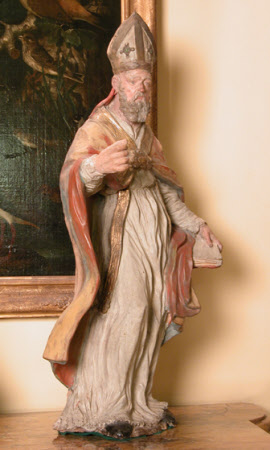A Bishop Saint
Austrian School
Category
Art / Sculpture
Date
c. 1700 - 1750
Materials
Painted and gilt terracotta
Measurements
776 x 415 mm
Place of origin
Austria
Order this imageCollection
Anglesey Abbey, Cambridgeshire
NT 513456
Summary
Painted and gilt terracotta, a Bishop Saint, Austrian or South German School, c. 1700-50. A large painted and gilded terracotta statue of an unidentified Bishop Saint, made in Austria or Southern Germany in the early 18th century. Dressed in robes and with a bishop’s mitre (hat), he holds a book in his left hand, and would originally have held in his left hand a staff, now missing. A pair to a statue of a Bishop Saint holding a model of a church (NT 513457).
Full description
This spirited sculpture, full of elegant movement, forms a pair with a statuette of a bishop saint holding a church (NT 513457). These well-made and -painted sculptures must be products of the same workshop, but they seem to have been made in slightly different ways; in this figure the back is open, whereas in the companion figure it is closed except for two large holes made in the clay wall to allow gases to escape during the firing, thereby lessening the risk of the model shattering in the intense heat of the kiln. They are typical works of the Austrian or Southern German baroque. Figures of saints of this type are typically placed on pedestals flanking the main panel of altarpieces; among the many examples the Nothelfer-Altar by Wolf Weiβenkirchner the Younger of 1679, in the pilgrimage church of Maria Plain near Salzburg (Pretzell 1935, p. 40, Abb. 19), or the figures of Saint Peter and Saint Paul on the high altar of the Stadtpfarrkirche in Krems, in Lower Austria, made by Josef Matthias Goetz (1696-1760) between 1733-35 (Decker 1943, Abb. 192-93). These figures are generally life-size, as are for example a pair of rather larger figures, Saints Ambrose (?) and Augustine, in the Busch-Reisinger Museum, University of Harvard (inv. nos. 1959.126-27; Kuhn 1965, pp. 131-32, nos. 81-82), described as Austrian, c. 1725-50. The Anglesey Abbey saints may have been made as models, but they seem too finished for that purpose and are also probably too large. By way of contrast, a terracotta model of c. 1767 by Roman Anton Boos for a statue of Saint Maximilian, one of four adorning the facade of the Theatinerkirche in Munich, is only around half the size of these relatively large figures (Munich, Bayerisches Nationalmuseum, inv.no. Ker 393, height 37.3 cm; Bayerische Rokokoplastik vom Entwurf zur Ausführung, exh. cat., Bayerisches Nationalmuseum, Munich 1985, pp. 65-66, no. 55). It seems more probable therefore that these statues may have been made to stand in niches elsewhere on an altar, like for example a set of wood statues of the four Evangelists from the circle of Marian Rittinger (active 1683, died 1712), made c. 1702-05 and each about 36 cm. high, which stand in niches in the high altar tabernacle in the church of Heiligenkreuz bei Kremsmünster (Decker, Abb. 33, 155-58). Jeremy Warren 2020
Provenance
Bequeathed to the National Trust by Huttleston Rogers Broughton, 1st Lord Fairhaven (1896-1966) with the house and the rest of the contents
Credit line
Anglesey Abbey, The Fairhaven Collection (National Trust)
Makers and roles
Austrian School, sculptor South German School, sculptor
References
Pretzell 1935: Lothar Pretzell, Salzburger Barockplastik, Berlin 1935 Decker 1943: Heinrich Decker, Barockplastik in den Alpenländern, Vienna 1943 Kuhn 1965: Charles L. Kuhn, German and Netherlandish Sculpture 1280-1800. The Harvard Collections, Cambridge Mass.1965 Christie, Manson & Woods 1971: The National Trust, Anglesey Abbey, Cambridge. Inventory: Furniture, Textiles, Porcelain, Bronzes, Sculpture and Garden Ornaments’, 1971, p. 148.
